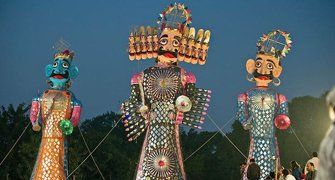Dussehra symbolizes victory of good over evil. The name of the festival derives from the Sanskrit words dasha (ten) and hara (defeat).
This festival is celebrated in India with utmost enthusiasm. People celebrate this festival by organizing magnificent fairs, enacting the famous Ramleela, huge crowds of people gather to watch Ravana effigies burn, and the aroma of traditional sweets and delicacies fills the air.
Also Read| Indian stock markets plunged nearly 6% since last Dussehra
Date
Dussehra usually marks the end of Navratri and this year Dussehra will be celebrated on October 5, 2022.
According to the Hindu lunar calendar, this festival is celebrated on Shukla Paksha Dashmi, which falls a day after Maha Navami or at the conclusion of Shardiya Navratri, in the month of Ashwin.
History
Dussehra also known as Vijaydashmi signifies triumph of good over evil and in Hindu mythology. There are two stories that explain the significance and purpose of this festival. Durga is said to have defeated Mahishasura on this day after a fierce battle that lasted more than nine days. Another mythology describes Ravana, the 10-headed demon king of Sri Lanka who desired Lord Rama’s wife Sita. Sita was kidnapped by Ravana and taken to his kingdom Lanka, where he held her hostage. Lord Rama went to Lanka with his brother Lakshman and Lord Hanuman, and he killed Ravana on the tenth day of the battle. The first nine days are known as Navratri, and the tenth day, when Ravana is killed, is known as Dussehra. As a result, Ravana’s death represents the triumph of good over evil.
Also Read| Why India celebrates Dussehra
Significance
The significance of this festival is intertwined. In various states, it is observed for different causes.
For instance, this festival is celebrated in West Bengal to celebrate Goddess Durga’s victory over the demon Mahishasura. In a procession accompanied by music and chanting, idols of Maa Durga, Saraswati, Lakshmi, and Lord Kartikeya are carried throughout the state. Vermilion is applied by women, and various colors are seen all over the place. This day is known as Bijoy Dashami.
It is observed as Vijayadashami in other states, where we celebrate Lord Rama’s victory over Ravana, who kidnapped his wife, Sita. Before going into battle, Lord Rama is said to have worshipped Goddess Durga in order to secure his victory and received her blessings. Arjun had also defeated every Kuru soldier on this day.
In all of the above, this festival justifies giving up all bad habits, adopting all positive traits, and facing one’s fears. People offer prayers for prosperity and health on this day.







